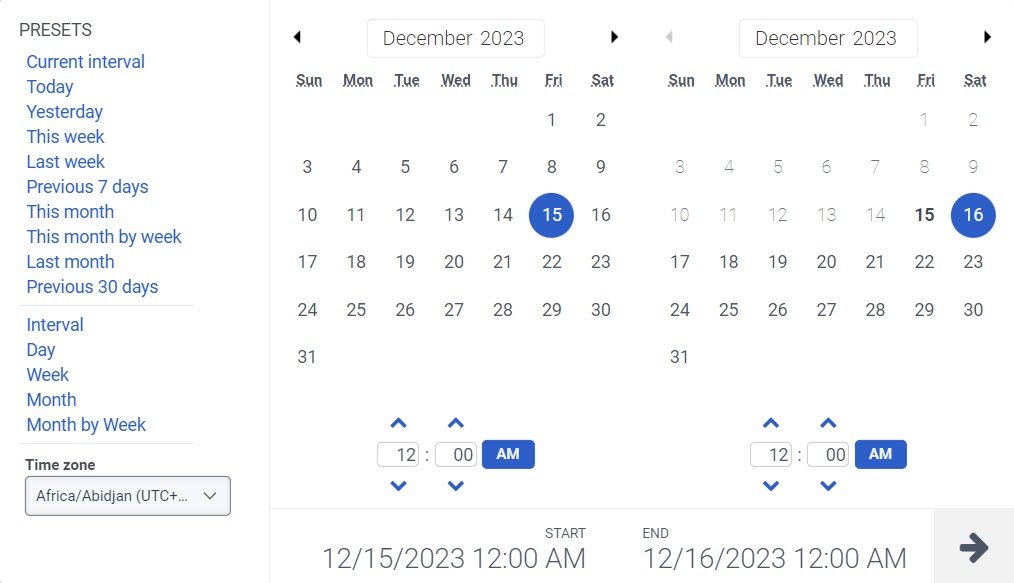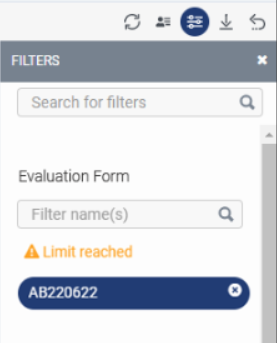Agents Evaluation Summary view
The following permissions
- Analytics > Data Export > All
- Directory > User > View
- Quality > Evaluation > View
- UI > Supervisor Agent Details > View
- Authorization > Role > View (to filter agent list by Role)
- Groups > Work Team > View (to filter agent list by Work Team)
- OAuth > Token > Delete (to log an agent out of Genesys Cloud)
- Telephony > Station > Disassociate (to disassociate an agent from a station)
The Agents Evaluation Summary view displays information about agent evaluations created during the selected time period. The view does not include calibration evaluations.
Available columns
To view the available columns, see the Agents Evaluation Summary view section in the View available columns in performance views by category article.
To view the consolidated list of available columns in the performance views, see Consolidated view of available columns in performance views.
To view the list of available columns in the performance views by category, see View available columns in performance views by category.
Set a default time zone in the workspace
You can set the default time zone in the analytics workspace before viewing any analytics view.
To set the default time zone in the workspace, follow these steps:
- Click Performance > Workspace.
- On the left side, from the Time zone drop-down menu, select the required time zone as the default time zone for the analytics workspace.
To view the Agents Evaluation Summary view:
- Click Performance > Workspace > Employee Engagement > Agent Evaluation.
- To see the most current data, click Refresh . This view does not update automatically.
- To filter for a form name, enter the form name in the Evaluation form filter. You can see the performance data about the respective evaluation form.
- To save the view with your filter and column settings, click Save .
- To export the data in the view, click Export .
- To see the Agents Evaluation Detail view, click an agent’s name.
- To access the other Agents Performance views, click the other tabs.
Customize the view
To show only certain data, customize the Agents Evaluation Summary view. For example, you can choose to show only certain columns or filter to show previous weeks. Your customizations remain as you navigate from view to view or leave and return to a view. To quickly switch between different data of interest in the same view, you can also save your filter and column settings as a saved view.
Filter by users to populate the summary row with aggregate data about those users.
The view displays data for evaluations that evaluators completed during the date range selected for the view.
To customize analytics views, use the date filter.
To filter metrics by date or configure a custom date range, use presets. When filtering metrics for this view, select any custom date range up to one month.
To use a preset to filter metrics, complete the following steps:
- Click the date to display the date filter.
- In the Presets list, select a preset date option.
Date presets
| Presets | Description |
|---|---|
| Current interval |
Shows data for the current 30-minute time period. |
| Today | Shows data for the time period that includes the current interval. |
| Yesterday | Shows data for the previous day. |
| This week | Shows data for a Sunday through Saturday time period. |
| Last week | Shows data for the previous week and Sunday through Saturday. |
| Previous 7 days | Shows data for the previous seven days. |
| This month | Shows data for the current month with no extra days. |
| This month by week | If the month does not start on Sunday or end on Saturday, shows data for the current calendar month starting on Sunday and ending on Saturday including extra days. |
| Last month | Shows data for the previous calendar month with no extra days. |
| Previous 30 days | Shows data for the previous 30 days. |
| Interval |
Shows data for a 30-minute time period. |
| Day | Shows data for a single 24-hour day. |
| Week | Shows data for a Sunday through Saturday time period. |
| Month | Shows data for the exact month with no extra days. If the current month is selected, you see the data up to the current date. |
| Month by Week | If the month does not start on Sunday or end on Saturday, shows data for a calendar month starting on Sunday and ending on Saturday including extra days. |
To use a custom date range to filter metrics, complete the following steps:
- To display the date filter, click the date.
- Select a start date and an end date on the calendar, and click the filter arrow .
To view data for a different time period using the same date presets, click the arrows on either side of the date display. ![]()
For example, to view data for the previous day, click the Day preset, and then click the arrow on the left side of the date.
To view data for a different time zone using the same date presets, from the Time zone drop-down menu, select the required time zone. You can create and save reports with the same selected time zone.
If you filter for a form name, you can see the performance data about the respective evaluation form. If you do not select an evaluation form, the data you are searching for is applied to every evaluation form.
- You can only find an evaluation form by the most recent published form name. Previous form names are not searchable.
- If a form was published previously, then the previous versions also appear in the results.
To show or hide columns:
- Click the Pick columns icon on the right side. The Add/Remove Column pane appears.
- (Optional) To sort the columns in ascending or alphabetical order, click Sort by > Column Name A-Z.
- (Optional) To sort the columns in descending or reverse alphabetical order, click Sort by > Column Name Z-A.
- (Optional) To categorize or uncategorize the columns, click Sort by and enable or disable the Group by Categories toggle. Click the image to enlarge.
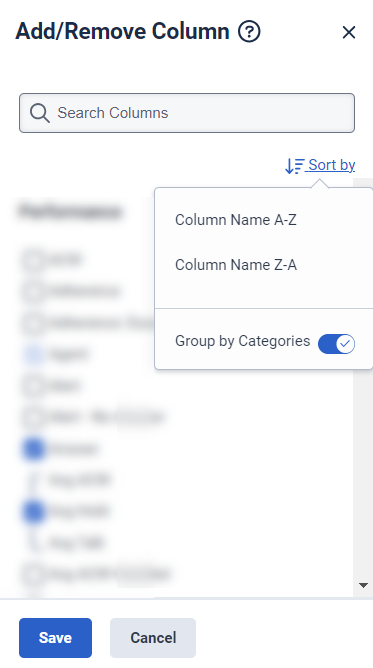
- Search or scroll to select the columns you want to view. Note: You can also use keyboard navigation to choose the columns.
- Click Save. The selected columns appear on the screen. Note: The column selections appear only after saving the changes and do not apply to the table immediately.
To rearrange the columns, click a column header and drag it.
To reset a view to default column settings, click Reset view to defaults ![]() .
.
You can select up to 20 columns.
For more information about the metrics shown in the columns, see the Available Columns section in this article.
To enter names of users you want to view, click the Filter user(s) search icon . Genesys Cloud populates the summary row with aggregate data about those users. You can filter by a User name, Division name, Group name, Work Team name, Role, or a Location. As you enter a name, the suggested names are displayed in the search results with the filtering type on the right. When entering a user name, you can also select the Reports to filtering type, to display the user's direct reports. You can continue to enter and select additional users to add to the view.
Filter by selecting multiple users
You can select multiple users to filter by.
- In the user's row, select the check box.
- Continue selecting user check boxes to add to filters.
- Click Add to filters.
To use the summary row to see aggregate metrics for multiple users, search for and select multiple users. The summary row then shows aggregate metrics for the selected users.
View aggregate data
To view aggregate data for several users, filter for multiple users and click View as group. Genesys Cloud displays the Agents Evaluation Detail view with aggregate data for the users that you selected. Use the Back arrow icon to return to the Agents Evaluation Detail view.
To filter the agent list by user type, in the top left-hand corner, choose any one of the required user types from the Active Users filter:
- Active Users (Default) – To filter only the active agents in the organization from the agent list.
- Inactive Users – To filter only the inactive agents in the organization from the agent list.
- Active and Inactive Users – To filter both the active and inactive agents in the organization from the agent list.
- Deleted Users – To filter only the deleted agents in the organization from the agent list.
From the Agents Evaluation Summary view, hover over the presence dot beside an agent’s name.
To set the agent's status to Off Queue or On Queue, select On Queue or Off Queue. If you change the status from On Queue to Off Queue, then the agent's status automatically also changes to Available.
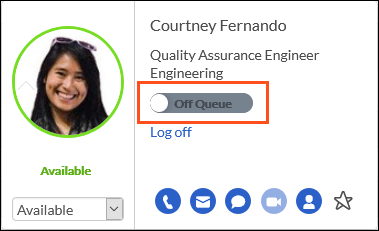
To set the agent's user status, select a status from the status drop-down. If the agent's status is On Queue, selecting a user status also sets them to Off Queue.
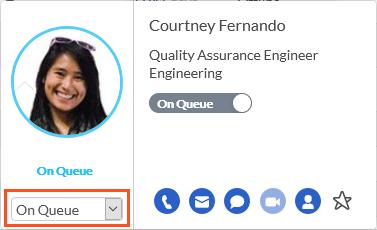
If the status you select has secondary statuses, select a secondary status in the drop-down below the primary status.
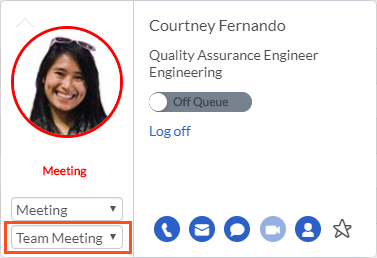
From the Agents Evaluation Summary view, hover over the presence dot beside an agent’s name.
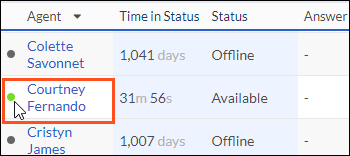
To log out an agent, click Log off. If the agent is On Queue, set the agent's status to Off Queue, and then click Log off.
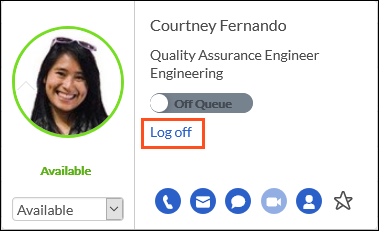
From the Agents Evaluation Summary view, hover over the presence dot beside an agent’s name.
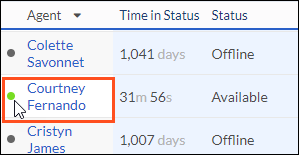
To disassociate an agent from the station, click Disassociate Station.


